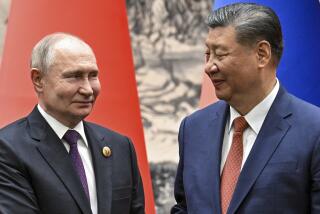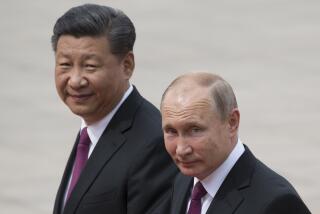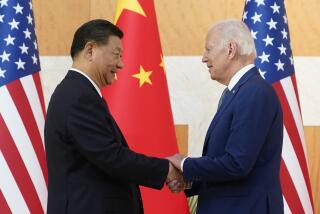Gorbachev in China : West Was Slow to See Depth of Communist Split : Khrushchev Felt Chill in Beijing
WASHINGTON — When Soviet leader Nikita S. Khrushchev’s propjet airliner touched down in Beijing on Sept. 30, 1959, the burly Russian was ready for a bitter confrontation with a man he had come to detest, Chinese Communist Party Chairman Mao Tse-tung.
“The warmth had gone out of our relations with China, and it had been replaced by a chill that I could sense as soon as I arrived,” the Soviet chief said in “Khrushchev Remembers,” the unofficial autobiography published in the West in 1974.
Sino-Soviet friction had been building for several years before the 1959 Khrushchev-Mao summit, and the icy estrangement between Communist giants would not reach its full bitterness for several more years.
Start of the Rift
But Khrushchev’s 1959 visit to China--together with an only slightly less tense trip in 1958--can be said to mark the start of the Moscow-Beijing split that Soviet President Mikhail S. Gorbachev and Chinese leader Deng Xiaoping hope to heal this week in the first Sino-Soviet summit since 1959.
The bitterness of the Mao-Khrushchev meeting seems clear with the benefit of almost 30 years of hindsight. But the depth of the Soviet-Chinese friction was not understood at the time in the West, which continued to view Moscow and Beijing as two pillars of a Communist monolith.
“The relationship had begun to come apart when Khrushchev became an outspoken critic of the Great Leap Forward,” Mao’s often brutal campaign for Chinese self-reliance in the mid-1950s, John King Fairbank wrote in “The Great Chinese Revolution,” published in 1986 . “On his two visits to Peking, in 1958 and 1959, he and Mao did not get along. The Russian leader thought the Chinese leader was a romantic deviationist whose judgment could not be trusted.”
On the Chinese side, there is now substantial evidence that Mao berated Khrushchev for what the Chinese leader considered a timid policy toward the Third World. Mao also complained that the Soviet Union gave only tepid support to China’s bombardment of an offshore island garrisoned by Nationalist Chinese troops from Taiwan.
But this evidence was largely overlooked in the West.
Herter’s Position
A few days after the 1959 Khrushchev-Mao summit, American Secretary of State Christian A. Herter told a Washington press conference that Moscow, because of its presumed place as the leader of the Communist world, bore “a degree of responsibility for the actions of other members of the bloc,” including China.
Herter noted, with apparent surprise, that the public statements of the Chinese and Soviet leaders during their summit exhibited disagreement over the basic approach to international disputes, with Khrushchev urging the peaceful settlement of conflicts and Mao advocating revolutionary force.
Khrushchev flew to China 31 hours after he returned to Moscow from a 10-day, coast-to-coast tour of the United States, which included talks at Camp David with President Dwight D. Eisenhower. Although Khrushchev’s U.S. trip was frequently marked by Cold War rhetoric on both sides, its overall impact was an easing of East-West tensions that came to be known as “the spirit of Camp David.” The detente proved to be short-lived.
In “Khrushchev Remembers,” the Soviet leader related that he was reluctant to go to China so soon after returning from the United States. The ostensible purpose of the China trip was to allow him to attend ceremonies marking the 10th anniversary of the Communist victory in the Chinese civil war.
But a major reason, at least from the Soviet standpoint, was dictated by rising border tensions between China and India. Khrushchev apparently hoped to serve as peacemaker between China and India, whose prime minister, Jawaharlal Nehru, the Soviet Union was assiduously courting.
“We were eager to give Nehru a chance,” Khrushchev wrote.
But from Mao’s standpoint, the Soviet neutrality in the border dispute between China and India was a betrayal of Communist solidarity. The Chinese said it was of little use to have the Soviet Union for an ally if it would not take their side in a disagreement with a non-Communist neighbor.
‘An Envoy of Peace’
In his public statements in Beijing, Khrushchev called on all Communist nations to “do everything possible to preclude war as a means for settling outstanding questions.” Premier Chou En-lai publicly referred to Khrushchev as “an envoy of peace.” But the Chinese leaders showed their displeasure with the summit by refusing to issue a joint communique at the end of the visit.
Khrushchev’s book, recalling the 1959 incidents and the later heavy border fighting between India and China in 1962, said:
“I believe it was Mao himself who stirred up the trouble with India. I think he did so because of some sick fantasy. He had started the war with India, and now he wanted to drag the Soviet Union into the conflict. Here was Mao trying to dictate policy to other socialist countries--just as Stalin had done before him. Here, once again, was the dictatorship of one individual masquerading as the dictatorship of the proletariat.”
Fairbank, the dean of U.S. China scholars, wrote that the Mao-Khrushchev animosity “reached the point in mid-1960 where Khrushchev suddenly withdrew all the Soviet technicians from China together with their blueprints.”
“The CCP (Chinese Communist Party) was soon sending ideological blasts against Soviet revisionism to the Communist Party of the Soviet Union and being paid back in kind.”
In the three decades since the last summit meeting between the Communist powers, the leaders of both China and the Soviet Union have met regularly with U.S. presidents.
Starting with President Richard M. Nixon’s visit to China in February, 1972, there have been seven Sino-American summits. And, counting Khrushchev’s 1959 trip to the United States, there have been 14 meetings between the top leaders of the United States and the Soviet Union.
More to Read
Sign up for Essential California
The most important California stories and recommendations in your inbox every morning.
You may occasionally receive promotional content from the Los Angeles Times.










